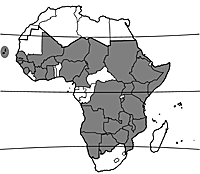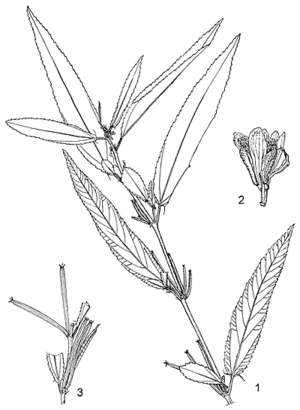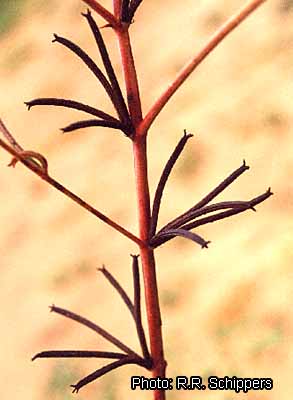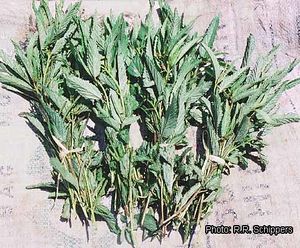Corchorus tridens (PROTA)
Introduction |
| General importance | |
| Geographic coverage Africa | |
| Geographic coverage World | |
| Vegetable | |
| Medicinal | |
| Forage / feed | |
| Fibre | |
| Food security | |
- Protologue: Mant. pl. 2: 566 (1771).
- Family: Tiliaceae (APG: Malvaceae)
- Chromosome number: 2n = 14
Vernacular names
- Jew’s mallow (En).
- Corète à trois dents (Fr).
- Coreté. (Po).
- Mlenda. (Sw).
Origin and geographic distribution
The genus Corchorus probably originates from Africa, with a secondary centre of diversity in the Indo-Burmese region. Corchorus tridens is widespread over tropical Africa and is also found in Nepal, Pakistan, India and Northern Australia. In Africa it occurs from Senegal in the west, east to Somalia and south to South Africa; it has been recorded for many countries. It is occasionally tolerated as a wild vegetable in crop fields with selective weeding, or grown in home gardens. It has some importance as a vegetable in Benin, Cameroon, Kenya, Mozambique, Niger, Nigeria and South Africa.
Uses
The leaves are used as a vegetable in stews eaten with starchy staple foods, and in soups and sauces. They taste more bitter than those of Corchorus olitorius L., the more commonly cultivated Jew’s mallow. Cooked leaves become mucilaginous and this drawing property is accentuated by addition of the filtrate of ashes. In West Africa and Malawi the plant has been used for its stem fibres, e.g. for fishing lines and rough cordage. Corchorus tridens is grazed by livestock.
Production and international trade
Corchorus tridens is utilized locally where it is collected as spontaneous vegetable in fallow land or where it is grown in home gardens and occasionally sold at the market. There are no statistical data, nor is there any international trade.
Properties
The composition of Corchorus tridens is probably comparable to that of Corchorus olitorius.
Adulteration
Okra and other Corchorus species are used in the same way: the cultivated Corchorus olitorius L. and the wild species Corchorus asplenifolius Burch., Corchorus fascicularis Lam., Corchorus trilocularis L. and Corchorus aestuans L.
Description
- Annual herb up to 1 m tall, usually erect and branched; stems reddish, fibrous and tough, often somewhat woody.
- Leaves alternate, simple; stipules setaceous, up to 1 cm long; petiole up to 1.5(–2.5) cm long; blade narrowly ovate to lanceolate or narrowly elliptical, 2.5–10(–12) cm × 0.5–3(–4.5) cm, rounded and with setaceous appendages up to 1 cm long at base, rounded, acuminate or acute at apex, margin serrate or crenate, sparsely pubescent, usually non-shiny and pale green, 3(–5)-veined from the base.
- Inflorescence a 1–4-flowered leaf-opposed fasciculate cyme, bracteate.
- Flowers bisexual, regular, usually 5-merous, shortly stalked; sepals free, narrowly elliptical to narrowly obovate, 3–5 mm long; petals free, narrowly obovate to narrowly oblanceolate, 4–5 mm long, yellow, caducous; stamens up to 20; ovary superior, 3-celled, style short.
- Fruit a slender cylindrical capsule up to 4 cm long and up to 2 mm wide, slightly ribbed, with 3 small spreading horns at apex, dehiscing by 3 valves, many-seeded.
- Seeds cylindrical, often somewhat quadrangular, c. 1.5 mm long, dark brown.
Other botanical information
The genus Corchorus comprises an uncertain number of species, with estimates ranging from 40–100. Corchorus tridens can be easily identified by the 3 small horns at the top of the slender capsules, which split at maturity with 3 valves. It seems closest to Corchorus aestuans, but this species has winged fruits.
Growth and development
The plants grow rapidly in the rainy season and flowering occurs about 6 weeks after germination. The first leaves can be picked at about 40 days after sowing. Flowering occurs continuously and seeds mature at 90–110 days from sowing. Fruiting plants can be found throughout the year.
Ecology
Corchorus tridens occurs in savanna, woodland and scrub vegetation, and often grows as a weed. It can be found up to 1700 m altitude, but is generally grown below 700 m. It is a hot season vegetable in dry areas. It is collected in the lowland African tropics throughout the year. Although it thrives best during the rainy season, it is rather drought resistant. It can tolerate a month without rainfall, but irrigation improves growth and yields. It also tolerates a high level of rainfall but is very sensitive to excess water when young. Favourable temperatures range from 22–35°C and diurnal variations within this bracket encourage leaf development. Corchorus tridens can be grown in a range of soil types but well-drained, alluvial or sandy loams are preferable. A soil pH of 6.5–7 is favourable, but it tolerates a pH between 5.5–8.5.
Propagation and planting
Corchorus tridens is predominantly collected from the wild and only occasionally cultivated. In cultivation, the same technology may be applied as for Corchorus olitorius. Seeds are sown directly on well-prepared, manured beds at the beginning of the wet season, broadcast or drilled in rows spaced at 20–30 cm. The seed rate is about 5 g per 10 m2. The plants are thinned to 20 plants per m2. Germination may be poor due to seed dormancy, but a short immersion in boiling water or soaking overnight in warm water speeds up germination and makes it less erratic. The seeds retain their viability for 8–12 months when stored in well-sealed jars.
Management
Weeding must be done early; thinning is done prior to the first harvest. Supplementary irrigation in a drought period is beneficial. Organic fertilizer may be applied at up to 20 kg per 10 m2 bed. A basal application with NPK, e.g. at 200 g per 10 m2, followed by a side dressing with nitrogenous fertilizer is recommended for optimum yield.
Diseases and pests
Major diseases include wilting by Sclerotium rolfsii and leaf spot by Cercospora corchori. Corchorus tridens is susceptible to red spider mites (Tetranychus urticae), yellow mites, leaf beetles (Podagrica sjostedji), sweet potato butterfly (Acraea acerata and Acraea terpsichore) and root-knot nematode (Meloidogyne spp.).
Harvesting
About 40 days after sowing, when the plants have made adequate foliage, harvesting is done every fortnight by topping leafy shoots. Harvesting stops when the plants are about 80 days old, when no new leaves are formed. Topping encourages branching and hence gives a higher yield. As flowering occurs concurrently with new leaf formation, flowers of leafy shoots are removed. Fruits become brown when mature and are harvested before shattering the seeds; they are threshed and winnowed to obtain seeds for sowing.
Yield
The leaf yield is about 5–8 kg per 10 m2 and is much reduced during the dry cool season.
Handling after harvest
Harvested leaves may be dried, made into powder and stored for a long period.
Genetic resources
Corchorus tridens is widespread and occurs in anthropogenic habitats, and thus does not seem liable to genetic erosion. There are no germplasm collections.
Prospects
Corchorus tridens is an interesting vegetable in dry environments, occurring spontaneously, but it can also be cultivated in home gardens. Seeds are easily procured and stored. It is a well-liked vegetable, easily preserved as dried leaf, nutritious and important in food security policy. Germplasm collection and research of Corchorus tridens should be promoted. However, in peri-urban cultivation it cannot compete with the higher yielding Corchorus olitorius.
Major references
- Burkill, H.M., 2000. The useful plants of West Tropical Africa. 2nd Edition. Volume 5, Families S–Z, Addenda. Royal Botanic Gardens, Kew, Richmond, United Kingdom. 686 pp.
- Edmonds, J.M., 1990. Herbarium survey of African Corchorus L. species. Systematic and Ecogeographic Studies on Crop Genepools 4. IBPGR/IJO, Rome, Italy. 284 pp.
- FAO, 1988. Traditional food plants: a resource book for promoting the exploitation and consumption of food plants in arid, semi-arid and sub-humid lands of Eastern Africa. FAO food and nutrition paper 42. FAO, Rome, Italy. 593 pp.
- Oliveira, J.S. & de Carvalho, M.F., 1975. Nutritional value of some edible leaves used in Mozambique. Economic Botany 29(3): 255–263.
- Schippers, R.R., 2000. African indigenous vegetables. An overview of the cultivated species. Natural Resources Institute/ACP-EU Technical Centre for Agricultural and Rural Cooperation, Chatham, United Kingdom. 214 pp.
- Singh, D.P., 1976. Jute, Corchorus spp. Tiliaceae. In: Simmonds, N.W. (Editor). Evolution of crop plants. Longman, London, United Kingdom. pp. 290–291.
- Stevels, J.M.C., 1990. Légumes traditionnels du Cameroun: une étude agrobotanique. Wageningen Agricultural University Papers 90–1. Wageningen Agricultural University, Wageningen, Netherlands. 262 pp.
Other references
- Figueiredo, E., 1995. Tiliaceae. In: Paiva, J., Martins, E.S., Diniz, M.A., Moreira, I., Gomes, I. & Gomes, S. (Editors). Flora de Cabo Verde: Plantas vasculares. No 23. Instituto de Investigação Científica Tropical, Lisbon, Portugal & Instituto Nacional de Investigação e Desenvolvimento Agrário, Praia, Cape Verde. 17 pp.
- Leung, W.-T.W., Busson, F. & Jardin, C., 1968. Food composition table for use in Africa. FAO, Rome, Italy. 306 pp.
- Machakaire, V., Turner, A.D. & Chivinge, O.A., 2000. Agronomic and nutrition studies of two indigenous vegetables in Zimbabwe: Cleome gynandra (Shona=Nyeve, Ndebele=Ulude) and Corchorus olitorius (Shona=Derere, Ndebele=Idelele). Acta Horticulturae 513: 145–152.
- Purseglove, J.W., 1968. Tropical Crops. Dicotyledons. Longman, London, United Kingdom. 719 pp.
- van der Zon, A.P.M. & Grubben, G.J.H., 1976. Les légumes-feuilles spontanés et cultivés du Sud-Dahomey. Communication 65. Département des Recherches Agronomiques, Koninklijk Instituut voor de Tropen, Amsterdam, Netherlands. 111 pp.
- Vollesen, K. & Demissew Sebsebe, 1995. Tiliaceae. In: Edwards, S., Mesfin Tadesse & Hedberg, I. (Editors). Flora of Ethiopia and Eritrea. Volume 2, part 2. Canellaceae to Euphorbiaceae. The National Herbarium, Addis Ababa University, Addis Ababa, Ethiopia and Department of Systematic Botany, Uppsala University, Uppsala, Sweden. pp. 145–164.
- Wilczek, R., 1963. Tiliaceae. In: Robyns, W., Staner, P., Demaret, F., Germain, R., Gilbert, G., Hauman, L., Homès, M., Jurion, F., Lebrun, J., Vanden Abeele, M. & Boutique, R. (Editors). Flore du Congo belge et du Ruanda-Urundi. Spermatophytes. Volume 10. Institut National pour l’Étude Agronomique du Congo belge, Brussels, Belgium. pp. 1–91.
- Wild, H., 1963. Tiliaceae. In: Exell, A.W., Fernandes, A. & Wild, H. (Editors). Flora Zambesiaca. Volume 2, part 1. Crown Agents for Oversea Governments and Administrations, London, United Kingdom. pp. 33–91.
Sources of illustration
- Stevels, J.M.C., 1990. Légumes traditionnels du Cameroun: une étude agrobotanique. Wageningen Agricultural University Papers 90–1. Wageningen Agricultural University, Wageningen, Netherlands. 262 pp.
Author(s)
- N.A. Mnzava, Oleris Consultancy, P.O. Box 1371, Arusha, Tanzania
Correct citation of this article
Mnzava, N.A., 2004. Corchorus tridens L. [Internet] Record from PROTA4U. Grubben, G.J.H. & Denton, O.A. (Editors). PROTA (Plant Resources of Tropical Africa / Ressources végétales de l’Afrique tropicale), Wageningen, Netherlands.
Accessed 31 March 2025.




